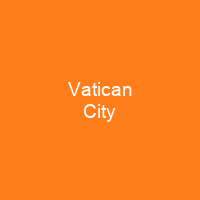Vatican City is an ecclesiastical or sacerdotal-monarchical state ruled by the pope. With an area of 49 hectares and a population of about 825, it is the smallest sovereign state in the world by both area and population. Within the Vatican City are religious and cultural sites such as St. Peter’s Basilica, the Sistine Chapel, and the Vatican Museums.
About Vatican City in brief

The Vatican City is a distinct territory under the sovereign authority and jurisdiction of the Holy see, itself a sovereign entity of international law, which maintains the city state’s temporal, diplomatic, and spiritual independence. The Holy See dates back to Early Christianity and is the principal episcopal see of theCatholic Church, which has approximately 1. 313 billion baptised Catholic Christians in theWorld as of 2017 in the Latin Church and 23 Eastern Catholic Churches. The name “Vatican” is derived from the name of an Etruscan settlement, Vatica or Vaticum located in the general area the Romans called Ageraticanus, \”Vatican territory’”. The name was already in use in the time of the Roman Republic for a marshy area on the west bank of the Tiber across from the city of Rome, located between the Janiculum, the Vatican Hill and Monte Mario, down to the Aventine Hill and up to the confluence of the Cremera creek. The unique economy of Vatican City. is supported financially by donations from the faithful, by the sale of postage stamps and souvenirs, fees for admission to museums, and sales of publications. It is also known as “The Vatican” and “the Vatican City City”.
You want to know more about Vatican City?
This page is based on the article Vatican City published in Wikipedia (as of Dec. 26, 2020) and was automatically summarized using artificial intelligence.







